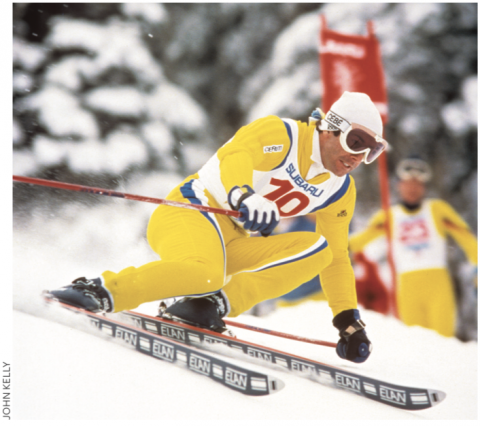
Who’s the greatest men’s giant slalom racer of all time? With each passing generation, racing fans renew the ongoing debate. By Peter Oliver
It’s a pot that sports fans of all stripes love to stir. Call it GOAT stew—who is or was the Greatest Of All Time? Football’s Tom Brady or Joe Montana or Johnny Unitas? Tennis’s Roger Federer or Rod Laver or Bill Tilden? The hagiology of sporting greats is reassessed with each passing generation.
So when Steve Porino, the thoughtful ski-racing TV commentator, suggested on air that in today’s World Cup men’s giant-slalom field Austria’s Marcel Hirscher, the U.S.’s Ted Ligety, and France’s Alexis Pinturault were the GS GOATs from their respective countries, the stewpot stirred on the hot stove of Porino’s Facebook page. All sorts of World Cup history buffs chimed in.
Hirscher? Yes, though with a strong challenge from Hermann Maier. Ligety? Certainly, though the Mahre brothers could arc pretty decent medium-radius turns, too. But Alexis Pinturault? A great GS racer to be sure, but had Porino forgotten a Frenchman named Jean-Claude Killy?
Pitting athletes of different eras against one another is always nettled with complication in the search for common comparative ground. And for the record, there’s little argument that the greatest GSer from any country was and is the inimitable Swede, Ingemar Stenmark, who won 46 World Cup GS races in a 16-year career.
But back to the Pinturault-Killy debate. Porino based his call, fairly enough, on total wins, and indeed, Pinturault passed Killy’s nine World Cup GS wins in December. But how about winning percentage instead? Pinturault wins about 17 percent of the World Cup GS races he enters—pretty darned good, until stacked against Killy’s brilliant GS winning rate of 82 percent.
To be fair, Killy’s World Cup career lasted just two seasons and 11 GS races (he was second and third in the two he didn’t win). So a very small sample. Still, Pinturault didn’t get his Killy-topping tenth World Cup GS win until his 59st start. Checkmark in the Killy column.
But not so fast. . .The shortness of Killy’s career gave him the unfair advantage of being in his prime for every World Cup race he entered. He was 23 years old when the World Cup was launched in 1967, and he retired at just 25. His World Cup record doesn’t include years of pre-prime apprenticeship, as Pinturault’s record does, nor late-career decline. Also, when Pinturault began as a 17-year-old in 2009, Ligety and Hirscher were already dominant World Cup forces.
 Raising another point: GS fields in Killy’s day weren’t as strong or deep. Switzerland’s Edmund Bruggmann and Austria’s Herbert Huber, second and third to Killy in the 1968 GS standings, were competent, but they were hardly Hirscher and Ligety.
Raising another point: GS fields in Killy’s day weren’t as strong or deep. Switzerland’s Edmund Bruggmann and Austria’s Herbert Huber, second and third to Killy in the 1968 GS standings, were competent, but they were hardly Hirscher and Ligety.
Killy was unquestionably the better all-rounder. He raced and won in three disciplines—slalom, GS, and downhill—and won 67 percent of all the World Cup races he entered. In today’s age of specialization, Pinturault has raced just four World Cup downhills, without distinction.
In 2018, however, Killy would probably be a specialist, too. The grueling 2017–18 World Cup schedule comprises 42 races, including Olympic events, discouraging all-event participation. The 1968 World Cup schedule, including three Olympic events, consisted of just 22 races. Last year, as a tech-event specialist, Pinturault still entered 26 World Cup races, 11 more than Killy did as an all-eventer in 1968.
 Almost no one attempts the Herculean effort of all-event racing today, especially when current World Cup scoring rules—very different than in Killy’s day—have allowed a specialist like Hirscher to win six straight overall titles without scoring points in a single downhill. As an all-eventer in winning his first World Cup overall title in 2005, Bode Miller entered a punishing 36 World Cup races (plus another five world championship races).
Almost no one attempts the Herculean effort of all-event racing today, especially when current World Cup scoring rules—very different than in Killy’s day—have allowed a specialist like Hirscher to win six straight overall titles without scoring points in a single downhill. As an all-eventer in winning his first World Cup overall title in 2005, Bode Miller entered a punishing 36 World Cup races (plus another five world championship races).
Pinturault’s career is obviously a long way from over. So, too, is the ongoing GOAT debate.
